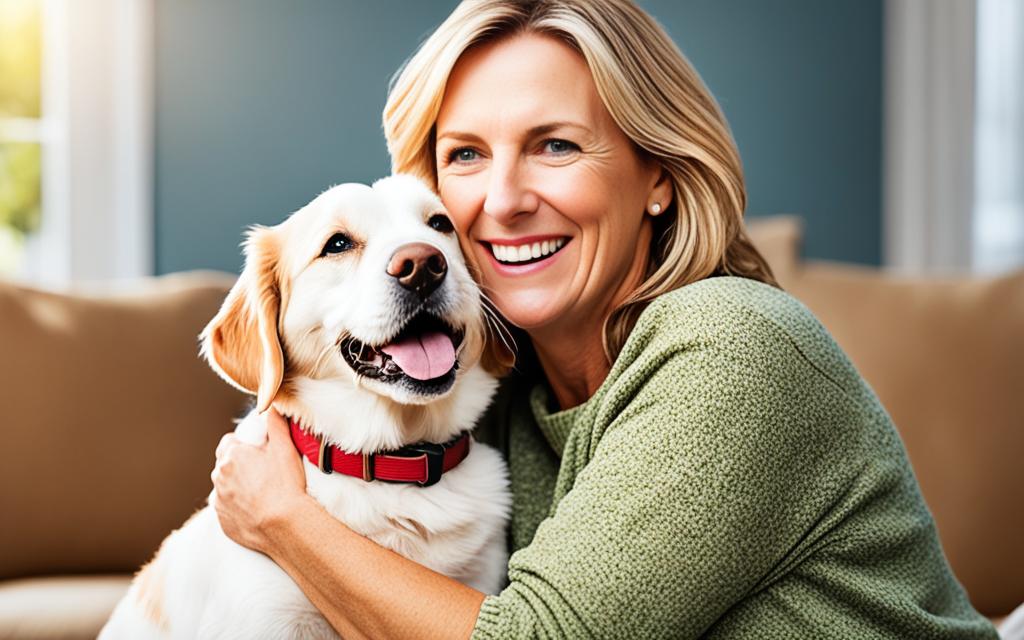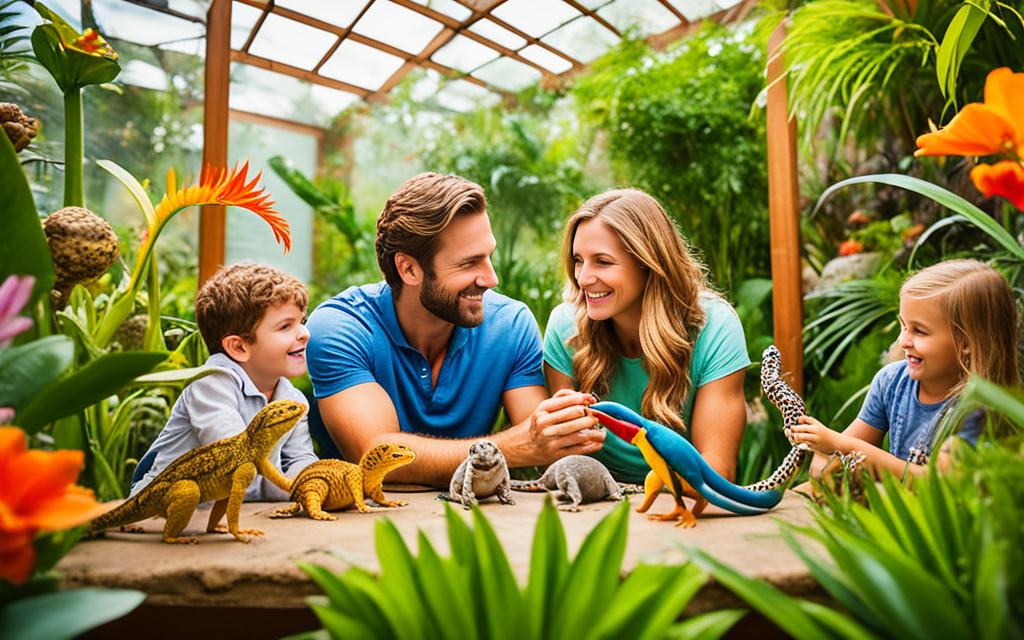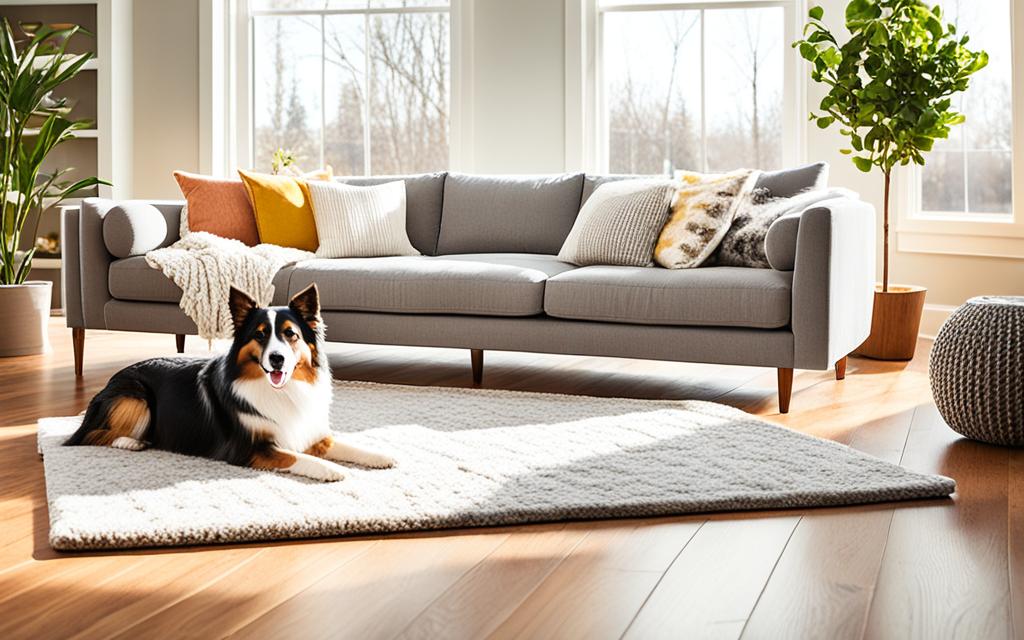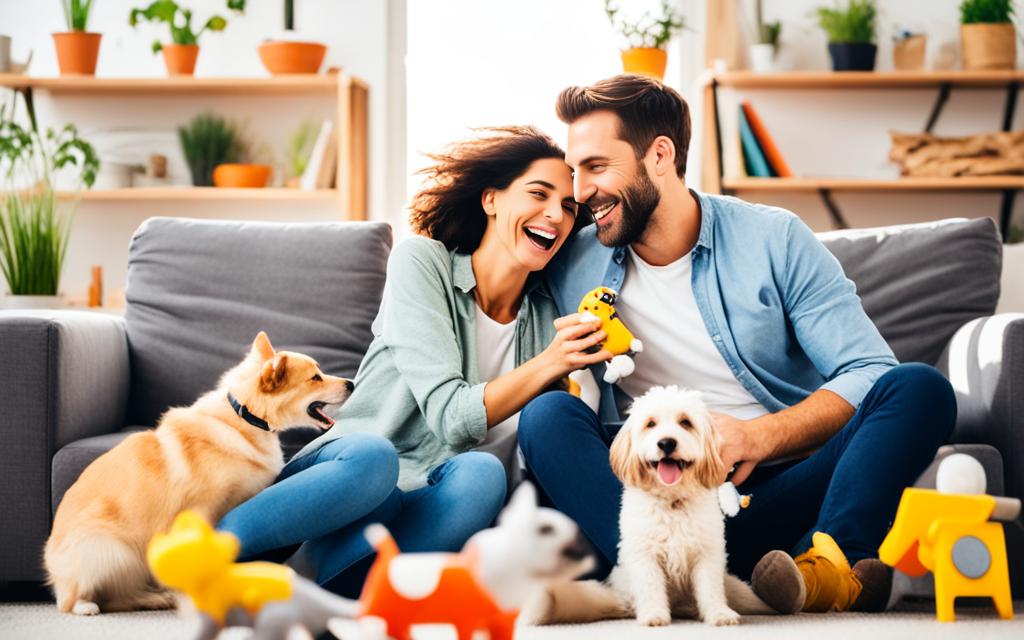Growing up with pets brings immense joy and enriches our lives in countless ways. Whether it’s a dog, cat, or any other furry friend, the experience of pet parenthood is truly joyful. Having a pet by our side offers companionship, love, and a special bond that can last a lifetime. In this article, I will explore the various benefits of pet ownership and provide valuable tips for raising a happy and healthy pet.
Key Takeaways:
- The joy of pet parenthood brings companionship, love, and a special bond.
- Pet ownership offers numerous benefits for our emotional and physical well-being.
- Raising a happy and healthy pet requires attention to their health, training, and overall well-being.
- Pets bring joy, love, and happiness to our lives, enhancing our overall quality of life.
- By understanding their needs and providing care and affection, we can foster a deep and meaningful connection with our pets.
The Joy of Pet Parenthood
As pet parents, we experience a unique sense of joy and fulfillment. The love and companionship our pets provide make every day brighter and more meaningful. From the excitement of coming home to a wagging tail or a purring cat to the joy of watching our pets grow and thrive, the journey of pet parenthood is truly special.
Pet parenting involves more than just caring for our furry companions; it encompasses creating a nurturing environment, ensuring their well-being, and forming a strong bond. By being attentive to their needs, providing proper nutrition, regular exercise, and veterinary care, we can ensure their happiness and longevity.
The bond between pet parent and pet goes beyond words. It’s a connection built on trust, loyalty, and unconditional love. Pets have an incredible ability to understand our emotions and offer support during difficult times. They provide companionship, easing our loneliness and bringing us comfort. Whether it’s playing fetch in the park, snuggling on the couch, or simply enjoying each other’s presence, the moments we share with our pets are irreplaceable.
“Having a pet in your life is like having a constant source of joy and companionship. They make us better human beings and bring immense happiness to our lives.” – Jane Smith, Pet Parent
Through the ups and downs of life, our furry friends are there for us, unconditionally. They teach us valuable life lessons such as patience, responsibility, and empathy. Taking care of a pet is a labor of love, but the rewards are immeasurable. The bond formed with our pets strengthens our emotional well-being, reduces stress, and improves overall mental health.
So, embrace the joy of pet parenthood and cherish the precious moments spent with your furry companions. Whether it’s a gentle purr, a wagging tail, or a contented sigh, these are the little moments that make life truly wonderful.
Benefits of Pets for Children’s Development
Children who grow up with pets experience numerous benefits that positively contribute to their development. Pets provide essential companionship, support, and emotional connection throughout life’s ups and downs. Additionally, pet ownership promotes an active lifestyle for kids, teaching them valuable life skills such as responsibility and empathy. Furthermore, exposure to pets from an early age can help reduce the risk of allergies and build a stronger immune system.
Companionship Through Life’s Ups and Downs
Having a pet by their side offers children constant companionship and unwavering support. Pets become their confidants, providing a source of comfort and emotional connection during challenging times. The bond formed with a pet can be a stable and consistent presence that brings joy and helps children navigate the complexities of life.
Promoting an Active Lifestyle for Kids
Pets encourage children to engage in physical activities and lead an active lifestyle. Whether it’s playing fetch with a dog or running around with a cat, interacting with pets stimulates movement and outdoor play. These activities not only contribute to physical fitness but also foster a love for nature and the outdoors, promoting a healthy and balanced lifestyle.
Teaching Responsibility and Empathy
Caring for a pet teaches children valuable life skills such as responsibility and empathy. Kids learn to take on tasks related to the care of their furry friends, including feeding, grooming, and ensuring they are well taken care of. This responsibility helps develop a sense of empathy as children recognize and meet their pet’s needs, promoting compassion and understanding.
Reducing Allergies and Building Immunity
Contrary to popular belief, exposure to pets from an early age can actually reduce the risk of allergies and help build a stronger immune system. Growing up around pets exposes children to various allergens, which can train their immune system to better tolerate these substances. As a result, children may develop fewer allergies and have a lower likelihood of developing asthma or other respiratory conditions.
Overall, having pets in a child’s life offers numerous benefits that contribute to their development and well-being. From companionship and an active lifestyle to cultivating responsibility, empathy, and reduced allergies, pets play an integral role in shaping a child’s growth and happiness.
Understanding the Human-Animal Bond
The bond between humans and animals is a remarkable connection that brings immense joy and comfort. Pets have the incredible ability to sense our emotions and provide unwavering support. They can attune themselves to our moods and offer comfort during difficult times.
Pets’ Attunement to Human Emotions
Pets are highly perceptive creatures, capable of recognizing and responding to our emotional states. Whether we are happy, sad, or stressed, our furry companions can sense these emotions and offer us solace. They have an innate ability to be there for us, providing unconditional love and support, regardless of the circumstances.

Nonverbal Communication and Companionship
While humans primarily communicate through words, pets communicate through nonverbal cues, creating a unique form of companionship. They rely on body language, facial expressions, and gestures to convey their feelings and understanding. This nonverbal communication deepens the connection between humans and animals, strengthening the bond we share. It allows us to tune into their needs and respond appropriately, further enhancing the relationship.
Understanding the human-animal bond is essential for appreciating the impact pets have on our well-being. Through their attunement to our emotions and nonverbal communication, they provide us with companionship, support, and an unwavering presence in our lives. This bond is a testament to the remarkable connection between humans and animals, highlighting the profound joy and comfort they bring.
Emotional and Physical Health Perks of Pet Ownership
The emotional and physical health benefits of owning a pet are numerous. Pets provide companionship and unconditional love, which can significantly reduce the risk of depression and anxiety.
Interacting with pets also lowers blood pressure, improves heart health, and promotes overall well-being. Studies have shown that pet owners have lower blood pressure levels compared to non-pet owners, which can be attributed to the calming effect of pet companionship.
Pet ownership has also been linked to reduced feelings of loneliness. For individuals experiencing social isolation or loneliness, furry friends offer solace and help create a sense of belonging. The emotional support provided by pets can alleviate feelings of loneliness and improve mental well-being.
| Emotional Health Benefits of Pets | Lower Blood Pressure and Heart Health | Pet Companionship for Loneliness |
|---|---|---|
| – Reduced risk of depression and anxiety | – Lower blood pressure levels in pet owners | – Alleviate feelings of loneliness and social isolation |
| – Unconditional love and companionship | – Improved heart health | – Provide emotional support |
| – Emotional connection and sense of belonging | – Calming effect of pet companionship | – Improve mental well-being |
Pet Ownership Extending Beyond Dogs and Cats
While dogs and cats are popular choices for pet ownership, there is a wide range of other animals that can bring joy to our lives. From small mammals like rabbits and guinea pigs to reptiles and birds, these unconventional pets can provide unique companionship and an enriching experience.
In fact, many small mammals make fantastic pets. Rabbits are known for their gentle demeanor and can be litter-trained, making them suitable for indoor living. Guinea pigs are social creatures that enjoy interacting with their owners and can be easily trained to do tricks.

Reptiles also offer a fascinating pet ownership experience. From geckos and snakes to turtles and iguanas, these creatures require special care, such as providing the right temperature and humidity for their habitats. However, with the right knowledge and commitment, owning a reptile can be a rewarding and educational experience.
For those interested in avian companionship, birds can be wonderful pets. From the vibrant colors of parrots to the melodic songs of canaries, birds offer beauty and entertainment. They require proper nutrition, regular veterinary check-ups, and ample socialization to thrive in a domestic setting.
| Pet Type | Characteristics |
|---|---|
| Small Mammals | Gentle, trainable, sociable |
| Reptiles | Fascinating, unique care requirements |
| Birds | Beautiful, entertaining, socialization needed |
A Guide to Integrating Exercise Through Pet Care
Taking care of a pet involves regular exercise and physical activity, which benefits both the pet and the owner. To ensure that your pet stays healthy and active, it is essential to integrate exercise into their daily routine. This section will provide you with a comprehensive guide to help you incorporate exercise into your pet care regimen, keeping both you and your furry friend fit and happy.
Fun and Rewarding Ways to Stay Active
Exercising with your pet doesn’t have to be a chore. There are plenty of fun and rewarding activities that you can enjoy together. Consider the following ideas to keep both you and your pet entertained while staying active:
- Go for daily walks: Walking is a simple yet effective way to get both you and your pet moving. Explore new routes, parks, and trails to make the experience more exciting.
- Set up playdates: Arrange playdates with other pet owners and their furry companions. This allows your pet to socialize while engaging in play and exercise.
- Try interactive toys: Invest in interactive toys that require physical activity, such as puzzle feeders or treat-dispensing toys. These will keep your pet mentally stimulated and physically active.
- Engage in agility training: Set up an agility course in your backyard or find a local training center that offers agility classes. This can help improve your pet’s coordination, strength, and overall fitness.
- Play fetch: A classic game of fetch can be an excellent cardio workout for both you and your pet. Use a ball or a Frisbee and enjoy some quality bonding time.
Building Routines with Your Pet
Building a routine is crucial when it comes to integrating exercise into your pet care regimen. Consider the following tips to establish a consistent and effective exercise routine:
- Determine the optimal exercise duration and frequency for your pet’s breed and age. Consult with your veterinarian to ensure you meet your pet’s specific needs.
- Set aside dedicated time each day for exercise. This will not only benefit your pet but also help you develop a healthy routine.
- Make exercise a habit by incorporating it into your daily activities. For example, you can choose to walk your pet before or after work.
- Keep track of your pet’s exercise routine using a fitness tracker or a simple journal. This will help you monitor their progress and make adjustments if necessary.
- Be consistent and patient. It may take time for your pet to adjust to a new exercise routine, so be patient and encourage them along the way.
The Calming Effect of Pet Companionship
The presence of pets has a calming effect on our lives and can significantly reduce anxiety and stress. Interacting with pets through petting, cuddling, or simply being in their company releases oxytocin, the “happiness” hormone, which promotes relaxation and emotional well-being.
Research has shown that the act of stroking a pet can lower cortisol levels, a hormone associated with stress, and increase the production of endorphins, which are natural mood enhancers. This soothing effect helps to alleviate anxiety and create a sense of calm.
Additionally, the comfort of routine and the responsibilities of pet care can provide a sense of stability and soothe anxieties. The consistency of a pet care routine, such as feeding, grooming, and exercise, can offer a comforting structure to our day-to-day lives.
Whether it’s taking a leisurely walk or curling up on the couch together, spending quality time with our pets allows us to relax and unwind. The simple presence of a pet can provide a source of comfort and companionship, easing feelings of loneliness and stress.
Overall, pets have a remarkable ability to create a calming and therapeutic environment. Their unconditional love and companionship can help us navigate the challenges of daily life and find solace in their presence.
“The presence of a loving pet can have a profound impact on our well-being, bringing a sense of comfort, peace, and joy into our lives.” – Dr. Sarah Thompson, Animal Behavior Specialist

Reducing Anxiety and Stress through Pet Interaction
Interacting with our pets has been proven to effectively reduce anxiety and stress levels. Engaging in activities such as playing, grooming, or even talking to our pets can provide a sense of comfort and emotional support.
When we interact with our pets, our bodies release oxytocin, a hormone that promotes relaxation and bonding. This hormone not only enhances our mood but also helps to reduce stress and anxiety. The simple act of petting a dog or cat can trigger this release of oxytocin, creating a calming effect on our nervous system.
In addition to physical interaction, the presence of a pet can offer emotional support during times of stress. Pets provide a nonjudgmental and unconditional love that can provide a sense of security and reassurance.
Research has shown that people who regularly interact with their pets have lower heart rates and blood pressure, indicating a reduced stress response. Furthermore, studies have demonstrated that the presence of a pet can lower levels of the stress hormone cortisol.
By engaging in meaningful interactions with our pets, we can tap into their inherent ability to reduce anxiety and stress, promoting a sense of calm and well-being in our lives.
The Comfort of Routine and Pet Care
Establishing a routine in pet care can provide a sense of comfort and stability in our lives. The responsibilities of feeding, grooming, and exercising our pets help to create a daily structure that can alleviate stress and anxiety.
Routine provides predictability and a sense of control, which is particularly valuable during uncertain or challenging times. The consistent care and attention we provide to our pets help us establish a rhythm and a sense of purpose.
Engaging in a pet care routine not only benefits our pets physically but also has a positive impact on our emotional well-being. It allows us to focus on the present moment and connect with our pets on a deeper level, fostering a sense of mindfulness and tranquility.
Moreover, taking care of our pets teaches us valuable lessons about responsibility and empathy. By meeting their needs, we develop a sense of fulfillment and purpose, further contributing to a more balanced and contented life.
In summary, the calming effect of pet companionship is undeniable. Our pets offer us a source of comfort, emotional support, and stability in our lives. Interacting with them reduces anxiety and stress, while the routine of pet care provides a sense of structure and purpose. By appreciating and nurturing our relationship with our pets, we can experience the numerous benefits they bring to our overall well-being.
Creating a Pet-Friendly Home Environment
Setting Up for Comfort and Safety
When creating a pet-friendly home, it’s important to consider the comfort and safety of your furry friend. Provide a cozy spot for them to relax, such as a designated pet bed or a soft blanket. Make sure their bed is placed in a quiet area of the house, away from noisy appliances or high foot traffic.
It’s also crucial to secure hazardous items and chemicals that could pose a danger to your pet. Store cleaning products, medications, and other potentially harmful substances in cabinets or high shelves that are inaccessible to your furry friend. Use childproof latches to prevent curious pets from opening cabinets.
Additionally, check your home for any small objects that could be easily swallowed by a pet. Keep small toys, buttons, batteries, and other small items out of reach to prevent choking hazards. Adhesive tapes and cords should be neatly tucked away to avoid any entanglement accidents.
Respecting Your Pet’s Space and Boundaries
Respecting your pet’s space and boundaries is essential for creating a harmonious living environment. Give your pet a designated area where they can retreat and relax when they need some alone time. This can be a specific room or a comfortable crate.
Teach family members, especially children, to respect your pet’s boundaries. Ensure they understand not to disturb your pet while they are eating, sleeping, or resting in their designated space. It’s crucial to establish boundaries that promote a sense of safety and security for your furry friend.
Provide your pet with proper supervision, especially when introducing them to new areas of the house or when guests visit. This will prevent any accidents or potential conflicts and allow your pet to feel secure in their environment.

Insight into Raising a Happy and Healthy Pet
Raising a happy and healthy pet is a responsibility that every pet owner should prioritize. By paying attention to their health and well-being, we can ensure that our furry friends live their best lives. This section will provide valuable insights into key aspects of pet care, including pet health and wellness checks and pet training tips for behavioral development.
Pet Health and Wellness Checks
A crucial part of maintaining your pet’s overall wellness is regular health checks. Just like humans, pets need routine check-ups to monitor their health and catch any potential issues early on. These health checks usually involve a thorough physical examination, vaccinations, parasite prevention, and discussions about any concerns you might have regarding your pet’s well-being.
Regular vet visits are essential for ensuring your pet’s health and longevity. Your veterinarian will be able to perform necessary tests, such as bloodwork and dental examinations, to ensure that your pet is in optimal health. They will also provide guidance on nutrition, exercise, and any additional preventive measures that might be needed.
Pet Training Tips for Behavioral Development
Effective training is not only crucial for maintaining discipline but also for ensuring your pet’s happiness and positive integration into the family. Training helps establish boundaries, communication, and mutual understanding between you and your pet. Here are some key training tips for behavioral development:
- Start early: Begin training your pet as soon as you bring them home. Consistency and patience are key during the early stages of training.
- Positive reinforcement: Use rewards, such as treats and praise, to encourage desired behaviors. Positive reinforcement creates a positive association and makes learning more enjoyable for your pet.
- Consistency: Be consistent in your training methods and expectations. This helps your pet understand what is expected of them and promotes successful learning.
- Socialization: Expose your pet to different people, animals, and environments to help them become well-rounded and confident. Early socialization plays a crucial role in shaping your pet’s behavior and temperament.
- Seek professional help if needed: If you encounter specific training challenges or need guidance, consider seeking help from a professional pet trainer. They can provide expert advice tailored to your pet’s individual needs.
Remember, training is an ongoing process that requires patience, consistency, and positive reinforcement. With proper training, your pet will develop essential behavioral skills and become a well-rounded member of your family.
Incorporating regular health checks and effective training into your pet’s routine will contribute to their overall happiness and well-being. By prioritizing their health and providing them with the necessary behavioral guidance, you can ensure that your pet leads a happy and healthy life.
Effective Strategies for Bonding with Your Pet
Bonding with our pets is a beautiful and rewarding experience. The love and connection we share with our furry friends can bring immense joy and fulfillment to our lives. In order to strengthen this bond, it is important to understand the unique language of our pets and recognize their signs of affection and stress. This section will explore effective strategies for bonding with your pet and building a strong and lasting connection.
Understanding Pet Love Languages
Just like humans, pets have their own unique love languages. It is essential to understand how your pet prefers to receive affection and show love in return. Some pets may enjoy physical touch, such as cuddling or gentle petting, while others may show affection through playtime or spending quality time together. By learning your pet’s love language, you can effectively communicate your love and strengthen your bond.
Recognizing Signs of Affection and Stress in Pets
Pets have their own ways of expressing affection and indicating when they are feeling stressed or anxious. It is important to be observant and recognize these signs to ensure the well-being of your pet. Signs of affection may include tail wagging, purring, nuzzling, or licking. On the other hand, signs of stress can include excessive barking or meowing, hiding, aggressive behavior, or changes in appetite. By understanding these signs, you can respond to your pet’s needs and provide them with the care and support they require.
| Signs of Affection | Signs of Stress |
|---|---|
| – Tail wagging | – Excessive barking or meowing |
| – Purring | – Hiding |
| – Nuzzling | – Aggressive behavior |
| – Licking | – Changes in appetite |
Understanding and responding to your pet’s needs can contribute to a stronger bond and a happier, healthier pet. By incorporating these effective strategies into your daily interactions, you can create a deep and lasting connection with your beloved pet.
Conclusion
The journey of growing together with pets is truly remarkable. The love, companionship, and unforgettable moments they bring enrich our lives in countless ways. Throughout this article, we have explored the various benefits of pet ownership and the joy of pet parenthood. By understanding our furry friends’ needs and providing them with care, affection, and a strong bond, we can create a happy and healthy life not only for them but also for ourselves.
Pets bring us immense happiness. They fill our days with love and laughter, and their unwavering companionship brings us comfort during both the good times and the bad. From the wagging tails to the soothing purring, the joys of being a pet parent are unparalleled. Our pets become family members, offering us a sense of purpose and fulfillment that cannot be replaced.
Embracing the journey of joyful pet parenthood means opening our hearts to the wonders of the human-animal bond. Our pets’ ability to sense our emotions, communicate without words, and offer nonjudgmental support is truly extraordinary. They teach us the beauty of pure love and remind us to cherish each moment. The happiness they bring to our lives becomes a cherished gift, one that we are forever grateful for.
So, let us celebrate the joy of pet happiness, pet love, and companionship. Let us embrace the adventure of joyful pet parenthood. And let us remember that in growing together with our beloved pets, we experience a happiness that is truly unmatched.
FAQ
What are the benefits of pet ownership?
Pet ownership brings immense joy and enrichment to our lives. Pets offer companionship, love, and a special bond that can last a lifetime. They promote an active lifestyle, teach responsibility and empathy, and can even reduce the risk of allergies and build a stronger immune system.
How do pets contribute to our overall happiness?
Growing up with pets and having them by our side offers constant companionship, love, and a sense of fulfillment. The excitement of coming home to a wagging tail or a purring cat, and watching our pets grow and thrive, brings immense joy and brightens our days.
How do pets benefit children’s development?
Pets play a crucial role in children’s development. They offer constant companionship, emotional connection, and support through life’s ups and downs. Growing up with pets promotes an active lifestyle, teaches responsibility and empathy, reduces the risk of allergies, and helps build a stronger immune system.
How do pets bond with humans?
The bond between humans and animals is remarkable. Pets have an incredible ability to sense our emotions and provide unwavering support. They communicate with us through nonverbal cues, creating a unique and deep companionship that goes beyond words.
What are the emotional and physical health benefits of owning a pet?
Owning a pet has numerous benefits for our emotional and physical health. Pets provide companionship and unconditional love, which can reduce the risk of depression and anxiety. Interacting with pets lowers blood pressure, improves heart health, and promotes overall well-being. They also offer solace and a sense of belonging for those experiencing loneliness.
Are there other pets besides dogs and cats that can bring joy to our lives?
Absolutely! There is a wide range of other animals that can bring joy to our lives. From small mammals like rabbits and guinea pigs to reptiles and birds, these unconventional pets can provide unique companionship and an enriching experience.
How can I integrate exercise into pet care?
Integrating exercise into pet care is essential for the health and well-being of both the pet and the owner. This can be done through fun and rewarding activities like daily walks, playtime, and interactive toys. Building routines and incorporating physical activity into your daily lives is key.
How do pets help reduce anxiety and stress?
Pets have a calming effect on our lives and can significantly reduce anxiety and stress. Interacting with them through petting, cuddling, or simply being in their company releases oxytocin, the “happiness” hormone, which promotes relaxation and emotional well-being. The comfort of routine and the responsibilities of pet care can also provide a sense of stability and soothe anxieties.
How can I create a pet-friendly home environment?
Creating a pet-friendly home environment is essential for the well-being and happiness of both the pet and the owner. This can be achieved by setting up a comfortable and safe space for your pet, respecting their boundaries, and ensuring their specific needs are met.
What are some tips for raising a happy and healthy pet?
Raising a happy and healthy pet involves regular health checks, vaccinations, and proper nutrition. It also requires effective training and behavioral development to ensure their happiness and positive integration into the family.
How can I bond with my pet?
Bonding with your pet is a beautiful and rewarding experience. Understanding their love languages, recognizing signs of affection and stress, and responding to their needs are all essential for building a strong connection.
Source Links
- https://www.helpguide.org/articles/mental-health/mood-boosting-power-of-dogs.htm
- https://www.purina.co.uk/find-a-pet/articles/getting-a-dog/adoption/benefits-of-dogs-for-children
- https://www.four-paws.org/our-stories/publications-guides/cuddling-with-pets

